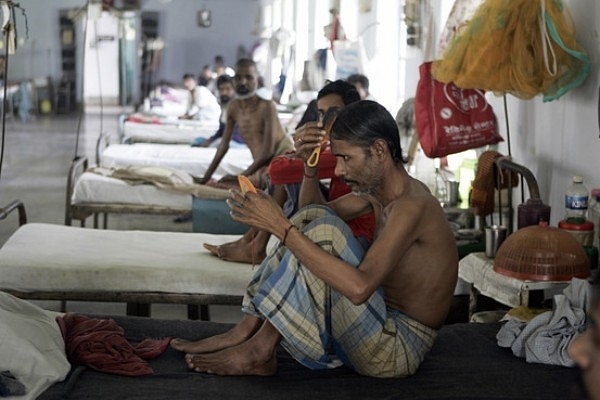
It’s Universal Health Care India Needs, Not Universal Basic Income; Digital Intervention Is The Way Forward
Universal Health Coverage (UHC) means that all individuals and communities receive the health services they need without suffering financial hardship
Digital interventions also open up a plethora of opportunities for the indigenous medical systems such as ayurveda, yoga and siddha.
World Health Organisation (WHO) has recently released a guideline document suggesting the scope and recommendations to using digital health interventions for strengthening the healthcare ecosystem. The world health assembly resolution on digital health held in May 2018 recognised the collective contribution of digital technologies to advancing universal health coverage and other health aims of Sustainable development goals. With this year’s World Health Day (7 April) theme being Universal health coverage, we can see the WHO’s call for participation from the global community towards the same.
Universal Health Coverage (UHC) means that all individuals and communities receive the health services they need without suffering financial hardship. It includes the full spectrum of essential, quality health services, from health promotion to prevention, treatment, rehabilitation, and palliative care. Multiple aspects come into play while talking about UHC such as, skilled workforce, health services, products (medicines, diagnostic equipment), finances (insurance cover, infrastructure investments), appropriate policies and necessary information repository. All these are required to work together even in times of crisis ensuring not just good health for the sick but also preventing people from falling sick.
Digital health intervention offers concrete solutions and opportunities in all the above mentioned aspects to help achieve UHC. For example decision support system in skilling health workers, telemedicine in making health services accessible, commodity management via inventory softwares, analytics on trends and patterns for health forecast. Digital Health encompasses employing Information and Communication Technologies (ICT) to address health needs that is both eHealth and mHealth (mobile/wireless technologies) and the whole gamut of use of advanced computing sciences in big data, genomics and artificial intelligence.
Analysis using the Tanahashi model, for understanding performance gaps in health systems, quality, affordability and blockage in intended coverage of health services, clearly indicates the ample scope for digital interventions to play a major role where ever the achievement falls short from the targeted levels. While the playing field has been identified for digital interventions it becomes crucial to set some ground rules. In this context the guidelines published by WHO is crucial as it provides for a critical evaluation of emerging digital health interventions based on benefit assessment, resource utilisation, equity considerations, feasibility and acceptability.
The recommendations in the guideline document are for prioritised digital health interventions accessible via mobile devices and it will evolve to include a broader set of emerging interventions. It also clearly states how such interventions are heavily context specific and how they feed into the larger goal of UHC. The guidelines document also recognises that digital health interventions should complement and enhance health system functions through mechanisms such as accelerated exchange of information, but will not replace the fundamental components needed by health systems such as the health workforce, financing, leadership and governance, and access to essential medicines.
The topics addressed currently are:
- Birth and Death notification
- Stock notification and commodity management
- Client-to-provider telemedicine
- Provider-to-provider telemedicine
- Targeted client communication
- Digital tracking of patients/clients health status and services
- Health worker decision support
- Provision of training and educational content to health workers (mobile learning-mLearning)
What’s In It For India
India slacks heavily in out patient department (OPD) in terms of lack of awareness of immunisation schedules for natal care, availability of doctors across primary health centres (PHC) especially in rural areas etc. The current national doctor-patient ratio is that of 1:921 inclusive of all systems of medicine. Lack of awareness of the effectiveness of traditional systems of medicines force non-allopathic doctors to prescribe allopathic drugs especially across rural PHCs’, out-of-pocket medical expenses in our country accounts for 62 per cent of total health care expenditure due to lack of insurance coverage. While schemes like Ayushman Bharat are helping the marginal and below poverty line families from falling into deeper debts, it becomes crucial to bring hospitals into the network to address supply chain issue and digital interventions will be of greater assistance in this area.
Digital interventions also open up a plethora of opportunities for the indigenous medical systems such as ayurveda, yoga and siddha. Traditional medical and healing systems suffer from lack of expert manpower and hence also result in dwindling acceptability rate. They are looked at as alternative systems and adopted only when all other options are exhausted. On the contrary they offer excellent preventive care solutions by providing for simple change in food and lifestyle choices and result in sustainable health and well-being. Awareness about such preventive care solutions ensures a healthy lifestyle thereby preventing people from falling sick often in the first place and help reduce the disease burden at the primary care level. Aiming for behavioural change and communication (BCC) module through mobile apps that share information such as daily 10 minute yoga routine, effective cooking practices ensuring holistic nutrition, model nutrition plates that are region specific etc, will provide for implementable actions. Establishing provider-to-provider and client-to-provider telemedicine ecosystem with respect to AYUSH health systems will ensure human resource availability, effective coverage, global acceptance and improve medical tourism.
From the affordability aspect of UHC, bringing AYUSH under insurance net can be accelerated by implementing these guidelines. At client entry points digital interventions would help capture more individual data such as frequency of patient visits, choice of medicine systems, method of arriving at diagnosis etc, in a standardised manner which would help churn out data driven quality research and help establish evidence based outcomes. These outcomes can then be used for analysing the effectiveness of policy implementation and bridge any plan-execution gaps. Such an effort will see a variety of experts converging across the spectrum and even result in the emergence of exciting trans-disciplinary areas of research.